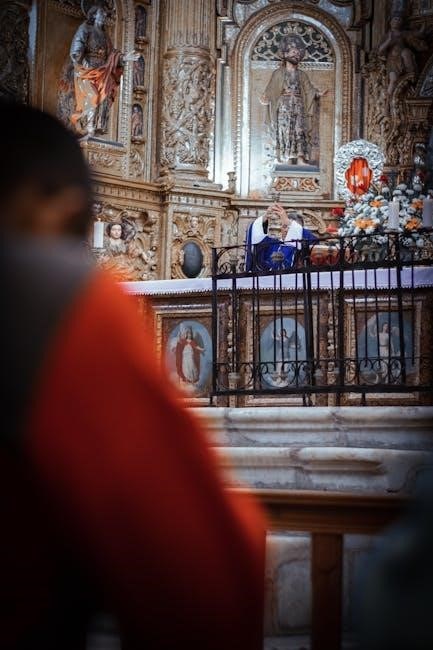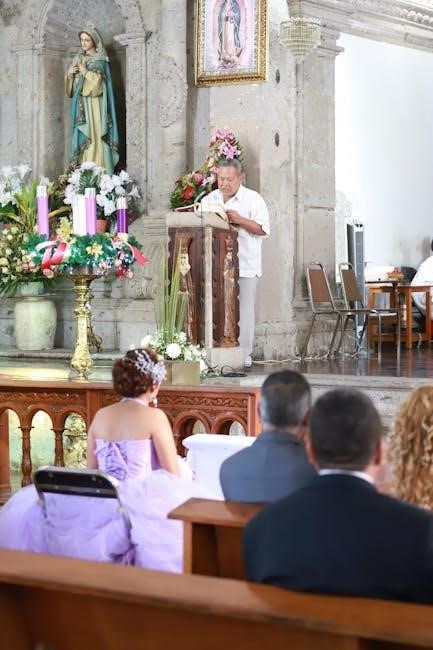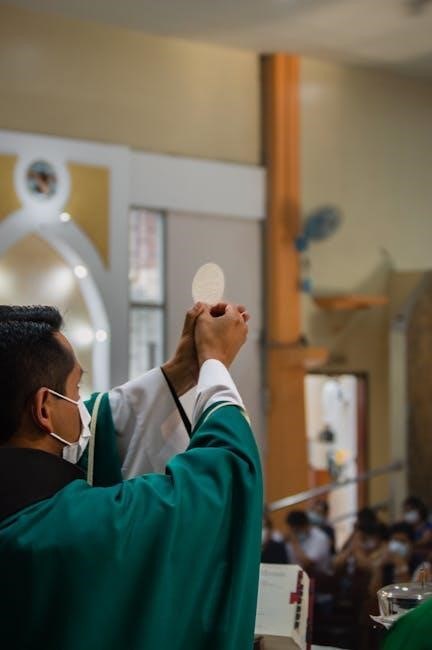The Latin Mass PDF serves as a comprehensive guide, offering the order of Mass, prayers, and chants. It aids participation and study, serving as a practical worship aid.
1.1 Definition and Significance of the Latin Mass
The Latin Mass, also known as the Traditional Latin Mass, is a form of Catholic worship rooted in centuries of liturgical tradition. It emphasizes the transcendent and sacrificial nature of the Eucharist, fostering a deep sense of reverence and spiritual connection. Its significance lies in preserving the Church’s liturgical heritage, offering a universal and timeless expression of faith across languages and cultures.

1.2 Purpose of the Latin Mass PDF
The Latin Mass PDF is designed to guide faithful participation in the Traditional Latin Mass, providing the order of Mass, prayers, and chants. It helps attendees follow the liturgy, understand its structure, and engage deeply with the sacred rites. This resource is ideal for personal study, communal worship, and fostering a meaningful connection to the rich liturgical heritage of the Catholic Church.

Structure of the Latin Mass
The Latin Mass follows a structured format, beginning with introductory rites, followed by the liturgy of the word, offertory, consecration, communion, and concluding rites, ensuring a reverent flow.
2.1 The Order of Mass in Latin and English
The Order of Mass is presented in both Latin and English, taken from the Missale Romanum (2008 edition). This dual-language format allows for easy reference and participation. The Latin text preserves the liturgical tradition, while the English translation ensures accessibility. The booklet includes the Kyriale (ordinary chants) and Mass Propers (changing parts), making it a practical aid for both study and active engagement in the liturgy.
2.2 Introductory Rites and Prayers
The Introductory Rites begin with the Sign of the Cross and the priest’s invocation, “In nomine Patris, et Filii, et Spiritus Sancti.” The rites include the Penitential Act, where the faithful acknowledge their sins, saying, “Confiteor Deo omnipotenti.” This is followed by the priest’s prayer, “Indulgentiam, absolutionem, et remissionem peccatorum nostrorum;” These prayers prepare the congregation to participate fully in the liturgy.
2.3 The Liturgy of the Word and Eucharist
The Liturgy of the Word includes the Epistle, Gospel, and sermon, preparing the faithful for the Eucharistic sacrifice. The Liturgy of the Eucharist begins with Offertory prayers, followed by the Consecration, where bread and wine become Christ’s Body and Blood. The Agnus Dei is sung before Communion, emphasizing reconciliation and worship. This sacred rite unites the faithful with Christ and the Church.

Resources for the Latin Mass
Traditional Latin Mass resources include missals, prayer books, and online PDFs. These materials provide the complete order of Mass, prayers, and chants, aiding faithful participation and study.
3.1 Traditional Latin Mass Booklets and Missals
Traditional Latin Mass booklets and missals are essential resources, offering the complete order of Mass, prayers, and chants. They include introductory rites, the Liturgy of the Word, and Eucharistic prayers. Many booklets provide English translations alongside Latin text, facilitating active participation. Some, like the Kyriale, focus on musical settings, while others, such as the Liber Usualis, contain propers for specific liturgical days. These materials are invaluable for both congregants and scholars.
3.2 Online PDFs for Participation and Study
Online PDFs provide accessible resources for the Latin Mass, enabling faithful participation and scholarly study. Websites like ExtraordinaryForm.org offer complete Mass texts, while others feature English-Latin missals for easier follow-along. Many PDFs include musical notations, such as the Kyriale and Liber Usualis, aiding in chanting and liturgical engagement. These digital tools are invaluable for worshippers seeking to deepen their understanding and devotion to the Latin Mass tradition.
The Extraordinary Form of the Mass
The Extraordinary Form refers to the Tridentine Mass, a traditional liturgy preserved from earlier centuries. It emphasizes sacredness and continuity, offering a unique spiritual experience for the faithful.
4.1 Differences from the Ordinary Form

The Extraordinary Form differs in its use of Latin, traditional prayers, and structured rituals. It includes the Aspérges, Prayers at the Foot of the Altar, and the Last Gospel. The priest faces the altar (ad orientem), and the liturgy emphasizes sacredness and continuity. The Schola Cantorum chants the Mass Propers, distinguishing it from the more flexible Ordinary Form, which uses vernacular languages and modernized rituals.
4.2 Historical Context and Development
The Latin Mass traces its roots to the early Church, evolving over centuries. Standardized by the Council of Trent (1545-1563), it became known as the Tridentine Mass. The 1962 Missal of Pope John XXIII represents its final form before the Second Vatican Council. The Extraordinary Form was reaffirmed by Pope Benedict XVI in 2007, ensuring its continued use alongside the Ordinary Form, preserving its historical and liturgical richness.

Participating in the Latin Mass
Participating in the Latin Mass involves following the Missal, engaging in prayers, and respectful posture. It requires attention to the liturgical rites and sacred traditions to fully embrace the spiritual experience.
5.1 Tips for Attendees and Congregants
For those attending the Latin Mass, it is advisable to obtain a Missal for following the prayers and chants. Arrive early to prepare spiritually, and refrain from unnecessary conversation. Participate actively by joining in common parts of the Mass, such as the Kyriale and responses. Dress modestly and maintain a reverent posture to respect the sacred liturgy. Do not worry about keeping up with the priest; focus on prayerful engagement.
5.2 The Role of the Schola Cantorum
The Schola Cantorum plays a vital role in the Latin Mass, singing the Mass Propers and Kyriale to facilitate active participation. Their chants, such as the Introit, Offertory, and Communion antiphons, enrich the liturgy. Some congregations join in singing the Kyriale, while the Schola leads the more complex parts. This ensures the faithful can engage deeply in the sacred rites, fostering a sense of unity and devotion.

Liturgical Prayers and Translations
The Latin Mass PDF includes English-Latin Missal booklets and the Kyriale, providing faithful translations of prayers and chants. These resources ensure accurate recitation and deeper engagement with the liturgy.
6.1 English-Latin Missal Booklets
English-Latin Missal booklets in the Latin Mass PDF provide parallel texts, enabling worshippers to follow prayers in both languages. These booklets include the Ordinary (fixed prayers) and Proper (variable prayers) of the Mass. They are designed for clarity, allowing faithful participation and understanding. The PDF format ensures easy access on devices, making it a practical aid for both personal study and active engagement during the liturgy.
6.2 The Kyriale and Mass Propers
The Kyriale contains the chants for the Ordinary of the Mass, such as the Kyrie, Gloria, and Credo. The Mass Propers, found in the Liber Usualis, include chants specific to each liturgical day. These are often included in the Latin Mass PDF with English translations, enabling the congregation to follow and sing along. The Schola Cantorum typically sings these chants, fostering active participation in the liturgy.

The Priest’s Role in the Latin Mass
The priest leads the congregation, reciting prayers and performing sacred rites. His role is central, ensuring the liturgy’s proper execution and spiritual integrity, guided by tradition.
7.1 The Celebrant’s Prayers and Actions
The priest, as the celebrant, recites specific prayers like In nomine Patris and the Confiteor, leading the congregation. His actions, such as facing the altar and elevating the Host, are central to the rite. Gestures and chants align with tradition, ensuring the Mass’s sacred nature. The priest’s role is to guide the liturgy faithfully, using the Roman Missal for accuracy and devotion.
7.2 The Use of the Roman Missal
The Roman Missal is the official liturgical book guiding the Latin Mass. It contains the priest’s prayers, chants, and rubrics, ensuring the rite’s integrity. The Missal includes the Ordinary (fixed texts) and Propers (variable texts) for each Mass. Its structured format helps the celebrant lead the liturgy faithfully, while its Latin text preserves tradition. The Missal bridges the gap between ancient rites and modern accessibility for the faithful.

Community and Tradition
The Latin Mass fosters a sense of unity and continuity with centuries of Catholic tradition. It strengthens community bonds through shared liturgical practices and spiritual enrichment. Resources like PDF booklets support parishes in preserving this heritage, ensuring its relevance for modern congregations while honoring its historical roots.
8.1 The Significance of the Latin Mass in Modern Times
The Latin Mass remains deeply significant in modern times, connecting Catholics to centuries of liturgical tradition. It expresses the fullness of Catholic worship, serving as a bridge between past and present. Many find spiritual enrichment in its timeless rituals, fostering unity and continuity. The availability of Latin Mass PDF resources supports its accessibility, ensuring its relevance for contemporary congregations while preserving Catholic heritage.
8.2 Resources for Parishes and Congregations
Parishes and congregations can access Latin Mass PDF resources to support liturgical participation. These include missals, booklets, and online materials. Programs like the Order of Mass from 2008 and traditional prayer books provide structured guidance. Additionally, websites offering downloadable PDFs ensure easy access for both study and worship. These tools help communities maintain and deepen their engagement with the Latin Mass tradition effectively.
The Latin Mass PDF is a valuable resource, offering a comprehensive guide to the traditional liturgy. It supports participation, study, and spiritual growth, preserving the richness of Catholic heritage.
9.1 Final Thoughts on the Latin Mass PDF
The Latin Mass PDF is an invaluable resource, providing a detailed guide to the Traditional Latin Mass. It aids in participation, serves as a reference for study, and supports spiritual growth. By preserving the richness of Catholic liturgical heritage, it remains a timeless tool for both personal devotion and communal worship, fostering a deeper connection to the sacred traditions of the Church.
